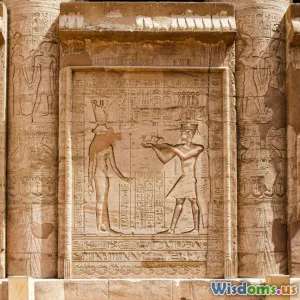
A Beginner’s Guide to Decoding Egyptian Hieroglyphs
8 min read Unlock the secrets of Egyptian hieroglyphs with this beginner’s guide—learn history, symbols, and decoding techniques step-by-step. (0 Reviews)
A Beginner’s Guide to Decoding Egyptian Hieroglyphs
Ancient Egyptian hieroglyphs — a magical script carved on temple walls, tombs, papyrus scrolls, and monuments — have fascinated scholars, adventurers, and history enthusiasts for centuries. Imagine walking among the pyramids and glimpsing these intricate symbols that once communicated the beliefs, daily life, and royal achievements of one of the world's most enduring civilizations. But how do you begin to decode a writing system that was shrouded in mystery until the 19th century? This guide unlocks the essentials to understanding, interpreting, and appreciating Egyptian hieroglyphs like a budding Egyptologist.
Understanding the Origins and Significance of Hieroglyphs
Hieroglyphs, derived from the Greek “hieros” (sacred) and “glyphe” (carving), meaning "sacred carvings," were developed over 5,000 years ago in ancient Egypt. Unlike alphabets, hieroglyphs combine logographic and alphabetic elements, making them both a language and an artistic tableau.
Historical Context
Hieroglyphics first appeared around 3200 BCE, shortly before the beginning of Egypt's Dynastic period. Their use lasted for nearly 3,500 years, waxing and waning in complexity. Hieroglyphs adorned the walls of temples, designed to ensure divine order and immortalize pharaohs' deeds. The combination of art and writing was thought to hold divine power, enabling words themselves to perform magical and ritual functions.
The Rosetta Stone: Cracking the Code
The breakthrough in understanding hieroglyphs came from the discovery of the Rosetta Stone in 1799 during Napoleon’s Egyptian campaign. The stone contains an inscription in three scripts: Greek, Demotic, and hieroglyphs. Jean-François Champollion famously decoded the ancient script in 1822 by comparing the Greek text with the hieroglyphs. His work unlocked access to millennia of Egyptian texts and history.
The Structure of Hieroglyphic Writing
At its core, Egyptian hieroglyphs consist of hundreds of symbols, with each symbol serving a specific purpose. Understanding their categories helps demystify the writing system.
Three Main Types of Hieroglyphs
-
Logograms: Symbols that represent whole words or ideas. For example, an image of a house stands for 'pr' (house).
-
Phonograms: Signs representing sounds (like alphabets). One symbol can be a single sound (unilateral), or combined (bilateral or trilateral) to form syllables. For example, the owl symbol represents the sound "m."
-
Determinatives: Non-phonetic signs placed at the end of words to clarify meaning, similar to context clues. For instance, a symbol of a man after a word indicates it relates to a person.
Directionality: Reading the Signs
Hieroglyphs can be written left to right, right to left, or even top to bottom. The direction can be identified by the way human and animal figures face — you read towards their faces. For example, if the glyphs face right, you read from right to left.
Common Symbols and Their Meanings
Starting with some common signs provides a foundation for beginners:
- Ankh (☥): Means "life" or "eternal life" — often held by gods.
- Djed Pillar: Symbolizes stability.
- Scarab Beetle: Represents transformation and rebirth.
- Eye of Horus: Protection, health, and royal power.
Understanding these symbols enriches reading and helps interpret context in texts.
Step-by-Step Decoding Tips for Beginners
Deciphering hieroglyphs may seem daunting, but these steps help get started:
1. Identify the Direction
Find the symbols facing—start reading towards their gaze.
2. Segment the Text
Separate blocks of symbols into words or phrases by spotting determinatives.
3. Analyze Symbol Types
Determine if each glyph is phonetic, logographic, or determinative. Use sign catalogs or guides for reference.
4. Sound It Out
Use phonograms (sound signs) to start ‘pronouncing’ words.
5. Use Context
Remember, many symbols are polysemous (multiple meanings). Decoding relies on context.
Practical Tools and Resources
Several resources make learning hieroglyphs accessible:
-
Gardiner’s Sign List: A categorization by Sir Alan Gardiner outlining 700+ common signs.
-
Hieroglyphic Dictionaries and Apps: Digital tools like JSesh (open source) and resources at The Griffith Institute.
-
Online Courses & Communities: Platforms like Coursera offer beginner-friendly classes; forums like r/AncientEgypt offer peer support.
Real-World Example: Decoding a Basic Phrase
Take the phrase found repeatedly on temple walls: “Nefertiti” (the famous queen).
- The symbols include a vulture (nen), a basket (f), and ‘t’ signs.
- Breaking it down: “nefer” = beautiful (vulture + heart) + “ti” = feminine suffix.
Understanding each component confirms both the pronunciation and meaning.
Why Learn Hieroglyphs Today?
Besides satisfying intellectual curiosity, learning hieroglyphs allows deeper appreciation of Egyptian culture and archaeology. It provides insight into ancient Egyptian religion, governance, art, and daily life. Archaeologists rely on decoding inscriptions to understand ancient sites, while historians reconstruct the civilization’s vast narrative.
Moreover, hieroglyphs inspire art, literature, and popular culture — decoding these symbols breathes life into silent stones, connecting us to humanity’s shared past.
Conclusion
Decoding Egyptian hieroglyphs transforms a seemingly impenetrable script into a vibrant language pulsing with history, art, and sacred meaning. By learning the symbols’ types, directionality, and uses, beginners can start to read tales etched in stone thousands of years ago. Choosing the right resources and continuing exploration can deepen this rewarding journey into one of civilization’s most majestic alphabets. As Champollion said, “The inscriptions are the keys that unlock the history of a people.” Now, equipped with this guide, you hold those keys.
Embark on this fascinating path from curiosity to understanding — the secrets of ancient Egypt await your discovery.
Rate the Post
User Reviews
Popular Posts





















